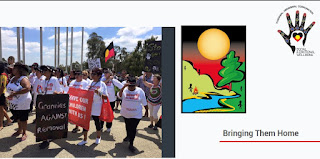It is easy to find accounts
of Australian aboriginal health – strictly Aborigines and Torres Strait
Islanders – that are lacking in hope. The standard narrative is that $billions
have been spent, but aboriginal families are characterised by violence,
alcohol, drugs, worklessness and high rates of crime.
Billions have been spent and aboriginal health is bad compared to the non-indigenous population – 11 years shorter
life expectancy for men and just under 10 years for women. But a different
account says that when people’s lives are characterised by betrayal of trust
and systematic destruction of identity and self-worth leading to powerlessness
perhaps it is no surprise that this Spiritual Sickness can lead to destructive
behaviours. Money spent is not irrelevant. But the psychosocial issues are
central. My starting position is that if communities and individuals are
empowered it is more likely that money spent will lead to progress.
On my recent trip to Sydney
to give the first Boyer Lecture for the ABC, the Australian Medical Association
wrote to ask how could they help. I said I would like to see examples of
doctors in action on social determinants of health. Prof Brad Frankum,
President, and Fiona Davies, Chief Executive of the New South Wales Branch of
AMA took me to Tharawal Community Centre in Campbelltown, a suburb 50 km
South-West of Sydney. Sydney spreads and spreads and spreads...
(the photos from the
Tharawal Aboriginal Corporation)
As I understand it, the two
names are emblematic of Australian history. The Tharawal people were the
original Aboriginal residents of the area. The Colonial Administration
established a settlement named after the Governor Macquarie’s wife, Elizabeth
Campbell. Indigenous people make up just over 3% of the Campbelltown population,
compared to 1.2% of greater Sydney.
The Centre was an inspiration.
I was shown around by two enthusiasts, aboriginal women, who were key in the
administration. I was also greeted by one of the doctors, Tim Senior, with a
sign:
The evening before, on ABC
Television’s national discussion programme, QandA, I had talked of a fairer
distribution of power, money and resources, and was told I was in Fantasy Land.
This aboriginal centre was making a difference. It was making fantasy a
reality.
Among its many roles is providing
medical care:
But it is a prime example of
what we mean by doctors working in partnership. As I went round the Centre, I
was shown where the ante-natal classes took place, and activities at every
stage of the life course: from early childhood
to older age:
“Bringing them home” is
significant. A psychologist at the Centre told me that she works with the
psychological consequences for children and the family of a child’s removal
from home. I asked if she was talking about the stolen generations – Aboriginal
children taken from their families between the 1890s and 1970s with the presumed
intent of destroying aboriginal culture. The psychologist said that it is still
going on. Children are removed because of family disruption but the
consequences are severe.
There is also a variety of services that deal
with the reality of people’s needs:
Not to mention subsidised
fruit and vegetables to make healthy eating more of a possibility:
We then came to the part of
the Centre that dealt with drug and alcohol problems:
I said to the woman in
charge: you must have the toughest job in this whole centre.
No, she said, I have the most
rewarding job.
She showed me a painting on
the wall. The man who painted this had come to the centre with huge problems of
drugs, alcohol and domestic violence. By the time he left, the centre had made
a step difference to him. He came back with this painting to say thank you.
I hold no illusions. There
are deep-seated structural problems that account for the dramatic life
expectancy gap between indigenous and non-indigenous Australians. But I
challenge anyone to come away from a visit to Tharawal and say it is all
hopeless. I saw evidence of community empowerment: a community controlling the
services needed for its population. To repeat, funding for services is vital,
as are good schools and job opportunities. But here was a centre dedicated to
improving things for its own community. Inspiring, indeed.







No comments:
Post a Comment